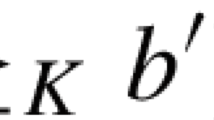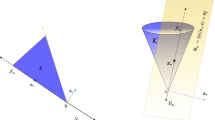Abstract
In this paper, using an optimal partition approach, we study the parametric analysis of a second-order conic optimization problem, where the objective function is perturbed along a fixed direction. We characterize the notions of so-called invariancy set and nonlinearity interval, which serve as stability regions of the optimal partition. We then propose, under the strict complementarity condition, an iterative procedure to compute a nonlinearity interval of the optimal partition. Furthermore, under primal and dual nondegeneracy conditions, we show that a boundary point of a nonlinearity interval can be numerically identified from a nonlinear reformulation of the parametric second-order conic optimization problem. Our theoretical results are supported by numerical experiments.


Similar content being viewed by others
Notes
In this context, \(\infty \) simply means that the primal problem is infeasible.
In this paper, strong duality means that the duality gap is zero at optimality, and the optimal sets \({\mathcal {P}}^*(\epsilon )\) and \({\mathcal {D}}^*(\epsilon )\) are nonempty.
Here, local boundedness is equivalent to uniform compactness in [23].
See [28, Example 3.1] for an instance of a parametric SDO problem with infinitely many singleton invariancy sets.
For this problem, both the primal and dual optimal set mappings are continuous at the transition point \(\epsilon = 0\).
For the ease of exposition, we simply rule out the existence of an invariancy interval here. Otherwise, as indicated in Remark 5, this procedure can also be applied to invariancy intervals.
Since \({\mathcal {P}}^*(\epsilon ) \times {\mathcal {D}}^*(\epsilon )\) is single-valued and locally bounded at \({\bar{\epsilon }}\), see (8), for every ball \({\mathbb {B}}_r\) of radius r centered at \(\big (x^*({\bar{\epsilon }});y^*({\bar{\epsilon }});s^*({\bar{\epsilon }})\big )\) there exists a neighborhood V of \({\bar{\epsilon }}\) such that \({\mathcal {P}}^*(\epsilon ) \times {\mathcal {D}}^*(\epsilon ) \subseteq {\mathbb {B}}_r\) for every \(\epsilon \in V\), see [34, Proposition 5.12(a)]. Therefore, it is always possible to find such an \({\hat{\epsilon }}\) with both desired properties.
The perturbation theory of invariant subspaces states that the eigenspace associated with the cluster of positive eigenvalues of \(L\big (x^{*i}({\bar{\epsilon }})\big )\) stays near that of \(L\big (x^{*i}({\hat{\epsilon }})\big )\).
On an open set \(U \subseteq {\mathbb {R}}\), a mapping f(x) is real analytic if for any given \(x_0 \in U\)
$$\begin{aligned} f(x)=\sum _{k=0}^{\infty } \frac{\big (f(x_0)\big )^{(k)}}{k!} (x-x_0)^k \end{aligned}$$for all x in a neighborhood of \(x_0\), where \((.)^{(k)}\) denotes the \(k{\mathrm {th}}\)-order derivative. See [25, Definition 1.1.5] for further properties of an analytic mapping.
In fact, using (20), (25), and (29) we can generate an optimal solution \(\big (x^*(\epsilon );y^*(\epsilon );s^*(\epsilon )\big )\) for \((\mathrm {P}_{\epsilon })\) and \((\mathrm {D}_{\epsilon })\), see [26, Section 3], which then proves to be unique for every \(\epsilon \) sufficiently close to \({\bar{\epsilon }}\).
Interestingly, the duality gap is zero at the boundary point \(\epsilon = 1-\sqrt{2}\), with the finite optimal value \(1/\sqrt{2}\). However, the optimal value of (32) is not attained, and its dual fails to have a strictly feasible solution.
As defined in [28, Definition 1.1], \(\big (X^*(\epsilon ),y^*(\epsilon ),S^*(\epsilon )\big )\) is a maximally complementary optimal solution of \((\mathrm {P}'_{\epsilon })\) and \((\mathrm {D}'_{\epsilon })\) if \({{\,\mathrm{rank}\,}}\!\big (X^*(\epsilon )\big ) + {{\,\mathrm{rank}\,}}\!\big (S^*(\epsilon )\big )\) is maximal on \(\mathcal {P}'^*(\epsilon ) \times \mathcal {D}'^*(\epsilon )\).
References
Adler, I., Monteiro, R.D.C.: A geometric view of parametric linear programming. Algorithmica 8(1), 161–176 (1992)
Alizadeh, F., Goldfarb, D.: Second-order cone programming. Math. Program. 95(1), 3–51 (2003)
Andersen, E., Roos, C., Terlaky, T.: On implementing a primal-dual interior-point method for conic quadratic optimization. Math. Program. 95(2), 249–277 (2003)
Basu, S., Pollack, R., Roy, M.F.: Algorithms in Real Algebraic Geometry. Springer, New York (2006)
Berge, C.: Topological Spaces: Including a Treatment of Multi-valued Functions, Vector Spaces, and Convexity. Dover Publications, Mineola (1997)
Berkelaar, A.B., Jansen, B., Roos, C., Terlaky, T.: Sensitivity analysis in (degenerate) quadratic programming. Technical Report 96-26, Delft University of Technology, Netherlands (1996)
Bertsekas, D.: Convex Optimization Theory. Athena Scientific, Nashua (2009)
Bonnans, J.F., Ramírez, C.H.: Perturbation analysis of second-order cone programming problems. Math. Program. 104(2), 205–227 (2005)
Bonnans, J.F., Shapiro, A.: Perturbation Analysis of Optimization Problems. Springer, New York (2000)
Cheung, Y.L., Schurr, S., Wolkowicz, H.: Preprocessing and regularization for degenerate semidefinite programs. In: Bailey, D.H., Bauschke, H.H., Borwein, P., Garvan, F., Théra, M., Vanderwerff, J.D., Wolkowicz, H. (eds.) Computational and Analytical Mathematics, pp. 251–303. Springer, New York (2013)
Dieudonné, J.: Foundations of Modern Analysis. Academic Press, New York (1960)
Fiacco, A.V.: Sensitivity analysis for nonlinear programming using penalty methods. Math. Program. 10(1), 287–311 (1976)
Fiacco, A.V.: Introduction to Sensitivity and Stability Analysis in Nonlinear Programming. Academic Press, New York (1983)
Fiacco, A.V., McCormick, G.P.: Nonlinear Programming: Sequential Unconstrained Minimization Techniques. Society for Industrial and Applied Mathematics, Philadelphia (1990)
Ghaffari-Hadigheh, A., Ghaffari-Hadigheh, H., Terlaky, T.: Bi-parametric optimal partition invariancy sensitivity analysis in linear optimization. Cent. Eur. J. Oper. Res. 16(2), 215–238 (2008)
Goldfarb, D., Scheinberg, K.: On parametric semidefinite programming. Appl. Numer. Math. 29(3), 361–377 (1999)
Goldman, A.J., Tucker, A.W.: Theory of linear programming. In: Kuhn, H.W., Tucker, A.W. (eds.) Linear Equalities and Related Systems, pp. 53–97. Princeton University Press, Princeton (1956)
Grant, M., Boyd, S.: Graph implementations for nonsmooth convex programs. In: Blondel, V., Boyd, S., Kimura, H. (eds.) Recent Advances in Learning and Control. Lecture Notes in Control and Information Sciences, pp. 95–110. Springer, New York (2008)
Grant, M., Boyd, S.: CVX: MATLAB software for disciplined convex programming, version 2.1. http://cvxr.com/cvx (2014)
Greenberg, H.J.: The use of the optimal partition in a linear programming solution for postoptimal analysis. Oper. Res. Lett. 15(4), 179–185 (1994)
Hang, N.T.V., Mordukhovich, B.S., Sarabi, M.E.: Second-order variational analysis in second-order cone programming. Math. Program. 180(1), 75–116 (2020)
Hauenstein, J.D., Mohammad-Nezhad, A., Tang, T., Terlaky, T.: On computing the nonlinearity interval in parametric semidefinite optimization (2019). arXiv:1908.10499
Hogan, W.W.: Point-to-set maps in mathematical programming. SIAM Rev. 15(3), 591–603 (1973)
Jansen, B., Roos, C., Terlaky, T.: An interior point approach to postoptimal and parametric analysis in linear programming. Technical Report 92-21, Delft University of Technology, Netherlands (1992)
Krantz, S.G., Parks, H.R.: A Primer of Real Analytic Functions. Springer, New York (2002)
Mohammad-Nezhad, A., Terlaky, T.: Quadratic convergence to the optimal solution of second-order conic optimization without strict complementarity. Optim. Methods Softw. 34(5), 960–990 (2019)
Mohammad-Nezhad, A., Terlaky, T.: On the identification of the optimal partition for semidefinite optimization. INFOR Inf. Syst. Oper. Res. 58(2), 225–263 (2020)
Mohammad-Nezhad, A., Terlaky, T.: Parametric analysis of semidefinite optimization. Optimization 69(1), 187–216 (2020)
Mordukhovich, B.S., Outrata, J.I.V., Sarabi, M.E.: Full stability of locally optimal solutions in second-order cone programs. SIAM J. Optim. 24(4), 1581–1613 (2014)
Nesterov, Y., Nemirovskii, A.: Interior-Point Polynomial Algorithms in Convex Programming. Society for Industrial and Applied Mathematics, Philadelphia (1994)
Oxtoby, J.C.: Measure and Category: A Survey of the Analogies between Topological and Measure Spaces. Springer, New York (1980)
Robinson, S.M.: Generalized equations and their solutions, part II: applications to nonlinear programming. In: Guignard, M. (ed.) Optimality and Stability in Mathematical Programming, vol. 19, pp. 200–221. Springer, Berlin (1982)
Rockafellar, R., Dontchev, A.: Implicit Functions and Solution Mappings: A View from Variational Analysis. Springer, New York (2014)
Rockafellar, R., Wets, R.J.B.: Variational Analysis, vol. 317. Springer, New York (2009)
Roos, C., Terlaky, T., Vial, J.P.: Interior Point Methods for Linear Optimization. Springer, New York (2005)
Sekiguchi, Y., Waki, H.: Perturbation analysis of singular semidefinite programs and its applications to control problems. J. Optim. Theory Appl. 188(1), 52–72 (2021)
Shapiro, A.: First and second order analysis of nonlinear semidefinite programs. Math. Program. 77(1), 301–320 (1997)
Sim, C.K., Zhao, G.: A note on treating a second order cone program as a special case of a semidefinite program. Math. Program. 102(3), 609–613 (2005)
Stewart, G.W.: Error and perturbation bounds for subspaces associated with certain eigenvalue problems. SIAM Rev. 15(4), 727–764 (1973)
Terlaky, T., Wang, Z.: On the identification of the optimal partition of second order cone optimization problems. SIAM J. Optim. 24(1), 385–414 (2014)
Todd, M.J.: Semidefinite optimization. Acta Numer. 10, 515–560 (2001)
Yildirim, E.: Unifying optimal partition approach to sensitivity analysis in conic optimization. J. Optim. Theory Appl. 122(2), 405–423 (2004)
Zlobec, S., Gardner, R., Ben-Israel, A.: Regions of stability for arbitrarily perturbed convex programs. In: Fiacco, A.V. (ed.) Mathematical Programming with Data Perturbations I, pp. 69–89. M. Dekker, New York (1982)
Acknowledgements
We would like to express our gratitude to the anonymous referees for their insightful comments and suggestions. We are indebted to Professor Saugata Basu for bringing the semi-algebraic properties of transition points to our attention.
Author information
Authors and Affiliations
Corresponding author
Additional information
This paper is dedicated to Marco Lopez on the occasion of his 70th birthday.
Publisher's Note
Springer Nature remains neutral with regard to jurisdictional claims in published maps and institutional affiliations.
This work is supported by Air force Office of Scientific Research (AFOSR) Grant # FA9550-15-1-0222.
Rights and permissions
About this article
Cite this article
Mohammad-Nezhad, A., Terlaky, T. On the sensitivity of the optimal partition for parametric second-order conic optimization. Math. Program. 189, 491–525 (2021). https://doi.org/10.1007/s10107-021-01690-7
Received:
Accepted:
Published:
Issue Date:
DOI: https://doi.org/10.1007/s10107-021-01690-7




